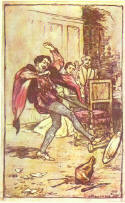ENG 3243
Current Spring 2007 Semester Syllabus
This course offers the
drama of the Middle Ages, Renaissance,
Restoration, and Neoclassical periods, including at least three plays by
Shakespeare. While appearing most often in
 the
fall semester of even-numbered years, that's always subject to change according
to demands. Past classes have
included Seneca's Thyestes, Everyman (anonymous),
the
fall semester of even-numbered years, that's always subject to change according
to demands. Past classes have
included Seneca's Thyestes, Everyman (anonymous),
 The Second
Shepherd's Play (probably by the so-called "Wakefield Master"),
Christopher Marlowe's Doctor Faustus,
William Shakespeare's The Taming of the Shrew, Measure For Measure,
and
King Lear, Oliver Goldsmith's She Stoops to Conquer, and
Richard Sheridan's
School for Scandal.
The Second
Shepherd's Play (probably by the so-called "Wakefield Master"),
Christopher Marlowe's Doctor Faustus,
William Shakespeare's The Taming of the Shrew, Measure For Measure,
and
King Lear, Oliver Goldsmith's She Stoops to Conquer, and
Richard Sheridan's
School for Scandal.
By all accounts, British Drama represents an astounding
corpus of the world's finest theatre, rivaled only by Greek tragedy and perhaps
the Spanish Golden Age.
 While
students often feel or are wrongly taught that earlier forms of drama become
succeeded by more sophisticated and "better" forms, the truth lies elsewhere.
Drama and literature may "evolve" to some degree, but newer doesn't always mean
better. In some instances, newer remains inferior to older forms; in other
instances, tastes change sufficiently that even generations far removed find
more satisfaction in the corpus of some periods over those of others.
While
students often feel or are wrongly taught that earlier forms of drama become
succeeded by more sophisticated and "better" forms, the truth lies elsewhere.
Drama and literature may "evolve" to some degree, but newer doesn't always mean
better. In some instances, newer remains inferior to older forms; in other
instances, tastes change sufficiently that even generations far removed find
more satisfaction in the corpus of some periods over those of others.
For instance,
 Shakespeare
remains with few exceptions, to represent a dramatic talent with a body of work
that in all respects seems more challenging, "sophisticated," and engaging than
the moral plays of his childhood's generation and earlier. The Corpus
Christi pageants offer another form of theatre, which cannot fairly be compared
to the Elizabethan Stage, anymore than one can rightly compare religious to
secular drama.
Shakespeare
remains with few exceptions, to represent a dramatic talent with a body of work
that in all respects seems more challenging, "sophisticated," and engaging than
the moral plays of his childhood's generation and earlier. The Corpus
Christi pageants offer another form of theatre, which cannot fairly be compared
to the Elizabethan Stage, anymore than one can rightly compare religious to
secular drama.
Yet, with the Restoration and Charles II ascendance to the Throne in 1660--after the closure of the theatres, beheading of Charles I, and the Commonwealth from 1642--playing quickly came back into fashion, with the first women seen on the English stage. For some, Restoration Drama remains an acquired taste, as much as does Shakespeare, but I would argue that the "Comedy of Manners" and corpus of works of the later 17th and early 18th Centuries takes far more "seasoning" to appreciate.
For our purposes, we begin with a work not part of the British Drama at all: Seneca, a Roman dramatist. But his work both inspired and informed the later Elizabethan and Jacobean Stages as had no other influence, so it becomes necessary to look at one of the best loved of his works by his later emulators. Following Seneca, in terms of time but not necessarily the syllabus, we'll look at a pageant play of Corpus Christi, a moral play or two, something by Christopher Marlowe, three plays by Shakespeare, and some representative Restoration works, whether Dryden's tragedies or the so-called "comedy of manners," featuring works by Congreve, Sheridan, Etheridge, or Goldsmith.
It's an ambitious semester's work; however, the variety of British theatricality--both religious and secular--remains astonishing. To leave any "representative" play out does a disservice, but that remains, unfortunately, the reality with such a great, national genre.
The Second Shepherd's Play January 19 - 24
Everyman January 26 - February 7
Thyestes February 9 - 21; [ Midterm February 23 ]
Hamlet February 26 - March 12 [ spring break: March 19 -23 ]
Twelfth Night March 26 - April 2
The Tempest April 4 - 11
The Beggars Opera April 13 - 20
She Stoops to Conquer April 23 -